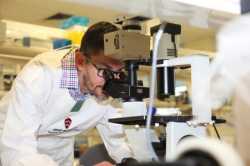Author Interviews, Biomarkers, Dermatology, JAMA, Pulmonary Disease, University of Pennsylvania / 12.08.2015
Penn Developed Sarcoidosis Score Reliably Measures Disease Activity
 MedicalResearch.com Interview with:
Misha A. Rosenbach, MD
Assistant Professor of Dermatology at the Hospital of the University of Pennsylvania
Assistant Professor of Dermatology in Medicine
Medical Research: What is the background for this study? What are the main findings?
Dr. Rosenbach: Sarcoidosis is an inflammatory disease of unknown etiology where genetically susceptible patients develop multi-organ granulomatous inflammation in response to an as-yet unidentified stimulus. Patients with sarcoidosis typically have granulomatous inflammation in their lungs, but the second most commonly affected organ is the skin; the eyes, lymph nodes, liver, heart, brain, and other organs can be affected as well. Patients with sarcoidosis can experience a few disease trajectories; some spontaneously recover, while others have persistent, active inflammation, whereas another group can experience inflammation which leads to scarring and fibrosis. It can be challenging to distinguish these cohorts of patients based on their lungs alone.
The skin is much easier to evaluate, as it is right there on the surface, and can be examined by physicians without resorting to invasive tests or radiography. At Penn, we developed a novel cutaneous sarcoidosis assessment tool, called the Cutaneous Sarcoidosis Activity and Morphology Instrument (CSAMI), which is designed to accurately measure how inflamed skin sarcoid lesions are in a given patient, as well as describing which type of cutaneous lesion patients’ have. The CSAMI has in previously studies been shown to be reliable when used by dermatologists, with excellent inter-rater and intra-rater reproducibility.
In this study, we had a group of Pulmonologists, Rheumatologists, and Dermatologists (representing the groups of physicians who most commonly care for patients with sarcoidosis, especially if there is skin involvement) evaluate a group of patients with cutaneous sarcoidosis, using the CSAMI and another sarcoidosis activity instrument, the SASI, which has also previously been used to measure skin sarcoidosis activity in a number of settings. We were able to demonstrate that these cutaneous scoring tools are reliable and reproducible and able to accurately measure cutaneous sarcoidosis disease activity in a variety of patients with a range of skin disease severity. We also compared the physician scores to patients’ own evaluations of their disease, and showed that the CSAMI (physician impression of disease) correlated well with patients’ own perception of their disease activity and severity.
(more…)
MedicalResearch.com Interview with:
Misha A. Rosenbach, MD
Assistant Professor of Dermatology at the Hospital of the University of Pennsylvania
Assistant Professor of Dermatology in Medicine
Medical Research: What is the background for this study? What are the main findings?
Dr. Rosenbach: Sarcoidosis is an inflammatory disease of unknown etiology where genetically susceptible patients develop multi-organ granulomatous inflammation in response to an as-yet unidentified stimulus. Patients with sarcoidosis typically have granulomatous inflammation in their lungs, but the second most commonly affected organ is the skin; the eyes, lymph nodes, liver, heart, brain, and other organs can be affected as well. Patients with sarcoidosis can experience a few disease trajectories; some spontaneously recover, while others have persistent, active inflammation, whereas another group can experience inflammation which leads to scarring and fibrosis. It can be challenging to distinguish these cohorts of patients based on their lungs alone.
The skin is much easier to evaluate, as it is right there on the surface, and can be examined by physicians without resorting to invasive tests or radiography. At Penn, we developed a novel cutaneous sarcoidosis assessment tool, called the Cutaneous Sarcoidosis Activity and Morphology Instrument (CSAMI), which is designed to accurately measure how inflamed skin sarcoid lesions are in a given patient, as well as describing which type of cutaneous lesion patients’ have. The CSAMI has in previously studies been shown to be reliable when used by dermatologists, with excellent inter-rater and intra-rater reproducibility.
In this study, we had a group of Pulmonologists, Rheumatologists, and Dermatologists (representing the groups of physicians who most commonly care for patients with sarcoidosis, especially if there is skin involvement) evaluate a group of patients with cutaneous sarcoidosis, using the CSAMI and another sarcoidosis activity instrument, the SASI, which has also previously been used to measure skin sarcoidosis activity in a number of settings. We were able to demonstrate that these cutaneous scoring tools are reliable and reproducible and able to accurately measure cutaneous sarcoidosis disease activity in a variety of patients with a range of skin disease severity. We also compared the physician scores to patients’ own evaluations of their disease, and showed that the CSAMI (physician impression of disease) correlated well with patients’ own perception of their disease activity and severity.
(more…)






















